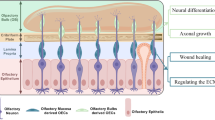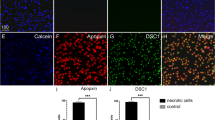Abstract
Inflammatory response following spinal cord injury (SCI) is important in regulation of the repair process. Olfactory ensheathing cells (OECs) and Schwann cells (SCs) are important donor cells for repairing SCI in different animal models. However, synergistic or complementary effects of co-transplantation of both cells for this purpose have not been extensively investigated. In the present study, we investigated the effects of co-transplantation of OECs and SCs on expression of pro- or anti-inflammatory factor and polarization of macrophages in the injured spinal cord of rats. Mixed cell suspensions containing OECs and SCs were transplanted into the injured site at 7 days after contusion at the vertebral T10 level. Compared with the DMEM, SC, or OEC group, the co-transplantation group had a more extensive distribution of the grafted cells and significantly reduced number of astrocytes, microglia/macrophage infiltration, and expression of chemokines (CCL2 and CCL3) at the injured site. The co-transplantation group also significantly increased arginase+/CD206+ macrophages (IL-4) and decreased iNOS+/CD16/32+ macrophages (IFN-γ), which was followed by higher IL-10 and IL-13 and lower IL-6 and TNF-α in their expression levels, a smaller cystic cavity area, and improved motor functions. These results indicate that OEC and SC co-transplantation could promote the shift of the macrophage phenotype from M(IFN-γ) to M(IL-4), reduce inflammatory cell infiltration in the injured site, and regulate inflammatory factors and chemokine expression, which provide a better immune environment for SCI repair.








Similar content being viewed by others
References
David S, Zarruk JG, Ghasemlou N (2012) Inflammatory pathways in spinal cord injury. Int Rev Neurobiol 106:127–152
Peruzzotti-Jametti L, Donega M, Giusto E, Mallucci G, Marchetti B, Pluchino S (2014) The role of the immune system in central nervous system plasticity after acute injury. Neuroscience 283:210–221
Ban DX, Kong XH, Feng SQ, Ning GZ, Chen JT, Guo SF (2009) Intraspinal cord graft of autologous activated Schwann cells efficiently promotes axonal regeneration and functional recovery after rat’s spinal cord injury. Brain Res 1256:149–161
Bottai D, Cigognini D, Madaschi L, Adami R, Nicora E, Menarini M, Di Giulio AM, Gorio A (2010) Embryonic stem cells promote motor recovery and affect inflammatory cell infiltration in spinal cord injured mice. Exp Neurol 223:452–463
Lopes A (2010) Olfactory ensheathing cells for human spinal cord injury. Neurorehabil Neural Repair 24(772–773):772–773
Salazar DL, Uchida N, Hamers FP, Cummings BJ, Anderson AJ (2010) Human neural stem cells differentiate and promote locomotor recovery in an early chronic spinal cord injury NOD-scid mouse model. PLoS One 5(8): doi: 10.137/0012272.
Alexanian AR, Fehlings MG, Zhang Z, Maiman DJ (2011) Transplanted neurally modified bone marrow-derived mesenchymal stem cells promote tissue protection and locomotor recovery in spinal cord injured rats. Neurorehabil Neural Repair 25:873–880
Chou RH, Lu CY, Fan JR, Yu YL, Shyu WC (2014) The potential therapeutic applications of olfactory ensheathing cells in regenerative medicine. Cell Transplant 23:567–571
Li L, Adnan H, Xu B, Wang J, Wang C, Li F, Tang K (2015) Effects of transplantation of olfactory ensheathing cells in chronic spinal cord injury: a systematic review and meta-analysis. Eur Spine J 24(5):919–930
Guest J, Santamaria AJ, Benavides FD (2013) Clinical translation of autologous Schwann cell transplantation for the treatment of spinal cord injury. Curr Opin Organ Transplant 18:682–689
Fouad K, Schnell L, Bunge MB, Schwab ME, Liebscher T, Pearse DD (2005) Combining Schwann cell bridges and olfactory-ensheathing glia grafts with chondroitinase promotes locomotor recovery after complete transection of the spinal cord. J Neurosci 25:1169–1178
Sun T, Ye C, Zhang Z, Wu J, Huang H (2013) Cotransplantation of olfactory ensheathing cells and Schwann cells combined with treadmill training promotes functional recovery in rats with contused spinal cords. Cell Transplant 22(Suppl 1):S27–S38
Gensel JC, Zhang B (2015) Macrophage activation and its role in repair and pathology after spinal cord injury. Brain Res 1619:1–11
Kigerl KA, Gensel JC, Ankeny DP, Alexander JK, Donnelly DJ, Popovich PG (2009) Identification of two distinct macrophage subsets with divergent effects causing either neurotoxicity or regeneration in the injured mouse spinal cord. J Neurosci 29:13435–13444
Murray PJ, Allen JE, Biswas SK, Fisher EA, Gilroy DW, Goerdt S, Gordon S, Hamiton JA, Ivashkiv LB, Lawrence T, Locati M, Mantovani A, Martinez FO, Mege JL, Mosser DM, Natoli G, Saeij JP, Schultze JL, Shirey KA, Sica A, Suttles J, Udalova I, Van Ginderachter JA, Vogel SN, Wynn TA (2014) Macrophage activation and polarization: nomenclature and experimental guidelines. Immunity 41(1):14–20
Cusimano M, Biziato D, Brambilla E, Donega M, Cervello CA, Snider S, Salan G, Pucci F, Comi G, Garcia-Verdugo JM, Palma MD, Martino G, Pluchino S (2012) Transplanted neural stem/precursor cells instruct phagocytes and reduce secondary tissue damage in the injured spina cord. Brain 135:447–460
Li BC, Xu C, Zhang JY, Li Y, Duan ZX (2012) Differing Schwann cells and olfactory ensheathing cells behaviors, from interacting with astrocyte, produce similar improvements in contused rat spinal cord’s motor function. J Mol Neurosci 48:35–44
Takami T, Oudega M, Bates ML, Wood PM, Kleitman N, Bunge MB (2002) Schwann cell but not olfactory ensheathing glia transplants improve hindlimb locomotor performance in the moderately contused adult rat thoracic spinal cord. J Neurosci 22:6670–6681
Basso DM, Beattie MS, Bresnahan JC (1995) A sensitive and reliable locomotor rating scale for open field testing in rats. J Neurotrauma 12:1–21
Omar M, Hansmann F, Kreutzer R, Kreutzer M, Brandes G, Wewetzer K (2013) Cell type- and isotype-specific expression and regulation of β-tubulins in primary olfactory ensheathing cells and Schwann cells in vitro. Neurochem Res 38(5):981–988
Ulrich R, Imbschweiler I, Kalkuhl A, Lehmbecker A, Ziege S, Kegler K, Becker K, Deschl U, Wewetzer K, Baumgartner W (2014) Transcriptional profiling predicts overwhelming homology of Schwann cells, olfactory ensheathing cell, and Schwann cell-like glia. Glia 62(10):1559–1581
Wewetzer K, Verdu E, Angelov DN, Navarro X (2002) Olfactory ensheathing glia and Schwann cells: two of a kind? Cell Tissue Res 309(3):337–345
Wewetzer K, Radtke C, Kocsis J, Baumgartner W (2011) Species-specific control of cellular proliferation and the impact of large animal models for the use of olfactory ensheathing cells and Schwann cells in spinal cord repair. Exp Neurol 229(1):80–87
Andrews MR, Stelzner DJ (2007) Evaluation of olfactory ensheathing and Schwann cells after implantation into a dorsal injury of adult rat spinal cord. J Neurotrauma 24:1773–1792
Chen KB, Uchida K, Nakajima H, Yayama T, Hirai T, Rodriguez Guerrero A, Kobayashi S, Ma WY, Liu SY, Zhu P, Baba H (2011) High-mobility group box-1 and its receptors contribute to proinflammatory response in the acute phase of spinal cord injury in rat. Spine 36(25):2122–2129
Pineua I, Lacroix S (2007) Proinflammatory cytokine synthesis in the injured mouse spinal cord: multiphasic expression pattern and identification of the cell types involved. J Comparative Neurology 500:267–285
Schwab JM, Brechtel K, Mueller CA, Failli V, Kraps HP, Tuli SK, Schluesener HJ (2006) Experimental strategies to promote spinal cord regeneration—an integrative perspective. Prog Neurobiol 78:91–116
Donnelly DJ, Popovich PG (2008) Inflammation and its role in neuroprotection, axonal regeneration and functional recovery after spinal cord injury. Exp Neurol 209:378–388
Moghaddam A, Child C, Bruckner T, Gener HJ, Danie V, Biglari B (2015) Posttraumatic inflammation as a key to neuroregeneration after traumatic spinal cord injury. Int J Mol Sci 16(4):7900–7916
Beck KD, Nguyen HX, Galvan MD, Salazar DL, Woodruff TM, Anderson AJ (2010) Quantitative analysis of cellular inflammation after traumatic spinal cord injury: evidence for a multiphasic inflammatory response in the acute to chronic environment. Brain 133:433–437
Vidal PM, Lemmens E, Dooley D, Hendrix S (2013) The role of “anti-inflammatory” cytokines in axon regeneration. Cytokine Growth Factor Rev 24(1):1–12
Li K, Nicaise C, Sannie D, Hala TJ, Javed E, Parker JL, Putatunda R, Regan KA, Suain V, Brion JP, Rhoderick F, Wright MC, Poulsen DJ, Lepore AC (2014) Overexpression of the astrocyte glutamate transporter GLT1 exacerbates phrenic motor neuron degeneration, diaphragm compromise, and forelimb motor dysfunction following cervical contusion spinal cord injury. J Neurosci 34(22):7622–7638
Sofroniew MV (2015) Astrocyte barriers to neurotoxic inflammation. Nat Rev Neurosci 16(5):249–263
Knerlich-Lukoschus F (2015) Chemokines and their receptors: important mediators to be aware of in neuroregenerative approaches for spinal cord injury. Neural Regen Res 10(4):562–564
Lakatos A, Franklin RJM, Barnett SC (2000) Olfactory ensheathing cells and Schwann cells differ in their in vitro interactions with astrocytes. Glia 32:214–225
Wolfs IM, Donners MM, de Winther MP (2011) Differentiation factors and cytokines in the atherosclerotic plaque micro-environment as a trigger for macrophage polarisation. Thromb Haemost 106:763–771
Gordon S, Martinez FO (2010) Alternative activation of macrophages: mechanism and functions. Immunity 32:593–604
Wang X, Cao K, Sun X, Chen Y, Duan Z, Sun L, Guo L, Bai P, Sun D, Fan J, He X, Young W, Ren Y (2015) Macrophages in spinal cord injury: phenotypic and functional change from exposure to myelin debris. Glia 63(4):635–651
Probert L (2015) TNF and its receptors in the CNS: the essential, the desirable and the deleterious effects. Neuroscience 302:2–22
Raposo C, Schwartz M (2014) Glial scar and immune cell involvement in tissue remodeling and repair following acute CNS injuries. Glia 62(11):1895–1904
Zhang B, Bailey WM, Braun KJ, Gensel JC (2015) Age decreases macrophage IL-10 expression: implications for functional recovery and tissue repair in spinal cord injury. Exp Neurol 273:83–91
Acknowledgments
This work was supported by grants from the National Natural Science Foundation of China (81371341); Funds of the State Key Laboratory of Trauma, Burn and Combined Injury (SKLZZ201003); Special Funds for Major State Basic Research Project, China (2012CB518106); and Youth Innovation Funds of Research Institute of Surgery, Third Military Medical University (2014YQN07).
Author information
Authors and Affiliations
Corresponding author
Ethics declarations
All the animals were housed according to the Third Military Medical University (TMMU) guidelines, and surgical procedures and post-operative care were conducted in accordance with protocols approved by the TMMU Institutional Animal Care and Use Committee.
Rights and permissions
About this article
Cite this article
Zhang, J., Chen, H., Duan, Z. et al. The Effects of Co-transplantation of Olfactory Ensheathing Cells and Schwann Cells on Local Inflammation Environment in the Contused Spinal Cord of Rats. Mol Neurobiol 54, 943–953 (2017). https://doi.org/10.1007/s12035-016-9709-5
Received:
Accepted:
Published:
Issue Date:
DOI: https://doi.org/10.1007/s12035-016-9709-5




